Army Combat Uniform
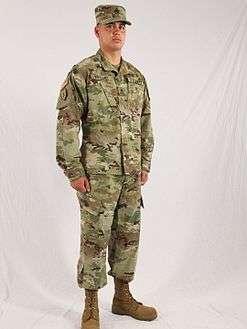
The Army Combat Uniform (ACU) and its flame-retardant variant, the Flame-Resistant Army Combat Uniform (FRACU), are the current battle uniforms worn by the United States Army. First unveiled in June 2004,[1] it is the successor to the Battle Dress Uniform (BDU) and Desert Camouflage Uniform (DCU) worn from the 1980s through the early 2000s, respectively.[2] It features a number of design changes, as well as a different camouflage pattern from its predecessor. The ACU and its component materials are manufactured by the existing industrial infrastructure which produced the now-obsolete BDU. Official military-grade ACUs are made of 50% nylon and 50% cotton. All other blends are not official issue.[3]
Patterns
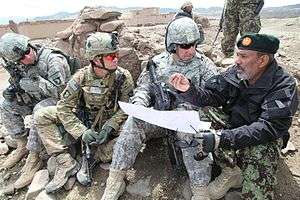
Universal Camouflage Pattern (UCP)
The U.S. Army uses the Universal Camouflage Pattern (UCP), which blends tan, gray and green (Desert Sand 500, Urban Gray 501 and Foliage Green 502) to work equally in desert, woodland, and urban environments.[4] It is similar to the United States Marine Corps MARPAT and Canadian CADPAT camouflage scheme on which it was based. The color scheme of the Army Combat Uniform is composed of a slate gray, desert sand and foliage green pixel pattern. The shade black was omitted from the uniform since it is highly visible both to the naked eye and to modern optics. However, it does utilize several shades of grey ranging from very light to extremely dark.[5] Pure black, when viewed through night vision devices, appears excessively dark and creates an undesirable high-contrast image.
Operation Enduring Freedom Camouflage Pattern (MultiCam)
U.S. Army soldiers deployed to Afghanistan (starting with the 173rd Airborne Brigade) are issued a version of the "MultiCam" pattern.[6] Since late 2010, all U.S. Army soldiers deploying in support of Operation Enduring Freedom are issued flame-resistant ACUs in the Operation Enduring Freedom Camouflage Pattern (OEFCP). These uniforms are designed to prevent third-degree burns, along with up to thirty percent of second degree burns. Additionally, the uniforms are treated with the chemical permethrin to help protect soldiers from insect-borne diseases like malaria. Some U.S. Army soldiers during the latter stages of the Iraq War also wore the ACU in OCP; some were seen wearing them as late as December 2011, when the United States withdrew its military forces from the country at the end of the war.
Operational Camouflage Pattern (OCP)
In May 2014, the Army unofficially announced that the Scorpion W2 camouflage pattern would replace the UCP on the Army Combat Uniform. The original Scorpion pattern was developed at United States Army Soldier Systems Center by Crye Precision in 2002 for the Objective Force Warrior program. Crye later modified and trademarked their version of the pattern as MultiCam, which was selected for use by U.S. soldiers in Afghanistan in 2010. After talks to officially adopt MultiCam broke down over costs in late 2013, the Army began experimenting with the original Scorpion pattern, noting that while a pattern can be copyrighted, a color palette cannot and that beyond 50 meters the actual pattern is "not that relevant." Scorpion W2 resembles MultiCam with muted greens, light beige, and dark brown colors, but uses fewer beige and brown patches and no vertical twig and branch elements.[7] On 31 July 2014, the Army formally announced that the Scorpion W2 pattern, officially named the Operational Camouflage Pattern, would begin being issued in uniforms in summer 2015. The name "Operational Camouflage Pattern" is to emphasize its use beyond Afghanistan to all combatant commands, with a family of versions including a dark jungle-woodland variant and a lighter pattern for deserts to follow.[8] The UCP pattern is planned to be officially replaced by the OCP in the ACU by 1 October 2019.[9] ACUs printed in OCP first became available for purchase on 1 July 2015, with deployed soldiers already being issued uniforms and equipment in the new pattern.[10]
Components

The Army Combat Uniform features hook-and-loop fasteners, also known by the genericized trademark velcro, on its sleeve pockets.
The cost to each soldier is $120 per uniform, compared to $58 for a BDU, but clothing allowances in soldiers' pay have been adjusted to compensate for the increased cost. Insignia and tags, such as name and branch tapes, are extra purchases.
Jacket
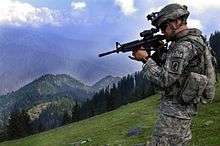
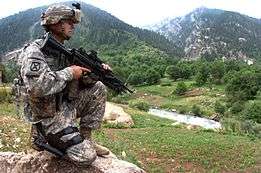
The ACU jacket uses hook-and-loop-backed attachments to secure items such as name tapes, rank insignia, and shoulder patches and tabs, as well as recognition devices such as the U.S. flag patch and the infrared (IR) tab.
Near Infrared (NIR) Signature Management Technology is incorporated to minimize the infrared silhouette. Permanent IR IFF squares are sewn to each shoulder to help identify friendly personnel when night vision devices are used, and are protected by Velcro tabs in garrison or when not in use.
Three U.S. flag insignia are authorized for wear with the ACU: full-color, full-color IR, and subdued IR. The U.S. flag insignia (full-color or subdued) is worn on the right shoulder pocket flap of the ACU coat. The subdued version is only worn as directed under tactical or field conditions.[11] On the right shoulder of the ACU, the U.S. flag is depicted with the union (stars) to the viewer's right, instead of the usual left (flag's own right); this is to give the impression of the flag moving forward with the wearer. Subdued shoulder sleeve insignia are always worn.
The jacket's Mandarin collar is worn up in combat to fit with the Improved Outer Tactical Vest (IOTV) body armor, and worn in the down position otherwise. The front closure is zippered and reinforced with velcro, designed for use with OTV. The tilted chest pockets, cuffs, and elbow pad insert pockets also utilize hook-and-loop closure. There is a three slot pen pocket on the left arm of the jacket, and blouse bellows for increased mobility.
Originally only pin-on skill badges were authorized for wear on the ACU, with no more than 5 at any one time. In the summer of 2011, regulations were changed to allow for wearing of sew-on embroidered skill badges like the ones worn on the older BDUs. The 5-badge limit remained in effect, and there could be no mixing of sew-on and pin-on badges. At the same time, the US Army nametape, personal nametapes, and rank insignia could be sewn-on at the wearers preference.[12] Skills tabs, such as the President's Hundred Tab, Special Forces, Ranger, and Sapper are worn on the left sleeve pocket flap, and are subject to a 3-tab-only rule.[13] A tab that is an integral part of a unit patch, such as the "Mountain" or "Airborne" tab, is not counted against the rule. The U.S. Army Chaplain insignia is the only authorized branch insignia to be worn on the ACU. It is centered 1/8 inch above the right name tape. The insignia may be the metal pin-on variety or the black embroidered insignia on digitized fabric with hook and loop (velcro) fasteners.[14]
Current regulations require the jacket to not extend below the top of the cargo pocket and not be higher than the bottom of the side pocket. Sleeves can be worn up or down at commanders's discretion,as of June 27, 2016.
In the field, the jacket may be replaced by the flame resistant Army Combat Shirt when worn directly under the IOTV.[15]
Trouser
The ACU trouser (or ACU pant) is worn with a two-inch nylon web belt, and features Velcro pouches for knee pad inserts, two forward-tilted thigh storage pockets with elastic drawstring and Velcro for closure during movement, and two calf storage pockets one on each pant leg with a Velcro closure. In addition, the pants legs can be bloused and must not extend past the third eyelet of the boots as per AR 670-1. Army Combat trousers with flame resistant materials are being issued for use in Iraq and Afghanistan.[15]
The updates to the ACU trousers in late 2010 included removal of Velcro fasteners from forward-tilted thigh cargo pocket flaps which were replaced with 3 buttons. This change was introduced gradually from 2009 onward and is now in full effect. 2 buttons are standard (same function as on BDU trouser cargo pockets), while the third button located at the very end of the pocket can be used to allow for more load and extra volume in cargo pockets. On small calf pockets the 3-piece Velcro (2 square hook on pocket and one rectangular loop patch on the flap) have been replaced with a single button in 2012. Buttons were re-introduced and replaced Velcro on pockets after numerous complaints from soldiers in the field. The belt loops are of new design, much wider (double width) and there is 8 of them now compared to 7 in the past. Waist adjustment cord has been removed and replaced by the Velcro waistband fine-adjusters, one at each hip. Instead of knee pocket which could only accommodate soft knee inserts in the past, the knee area now features multi-layered comprehensive design which allows external hard-type knee pads like the ones from Crye Precision to be inserted and secured. Back of the knee area has Velcro hook and loop patches to further secure knee inserts around the knee area. Cuffs at the bottom of the trousers do not use drawstrings anymore for blousing - those have been again replaced by the Velcro cuff adjusters.A total of 32,000 uniforms were initially requested by the US Army for their troops in Afghanistan. US Army PEO Soldier selected a 'new' camouflage pattern for soldiers in Afghanistan theatre, called Scorpio W2. Scorpio W2 is closely based on the original Scorpion with minor pattern changes and no licensing fees requirements.
In addition, the American troops deployed in Iraq and Afghanistan are since 2010 issued with 4 sets of Flame-Resistant version of ACU (FRACU) which is made in Ripstop and twill variants of the material known as 'Defender M' containing 65% flame-resistant Rayon, 25% Para-ARAMID and 10% Nylon. The look and feel of Defender M in Ripstop is very similar to the mil-spec 50% Nylon/50% Cotton NYCO Ripstop material used for standard ACU uniforms. It is lightweight, breathes and dries well, which are all features of NYCO Ripstop. There is also a version of Defender M made of twill with the same flame resistant material composition as the Ripstop version. Twill FRACU is to be issued as a combat uniform to the US troops operating in a temperate climate, different from the current combat theaters of Iraq and Afghanistan. To be able to differentiate the FRACU from ACU at a distance, a small square inch tan patch is affixed to left sleeve cuff on the jacket and middle of left cargo pocket flap on the trousers. Defender M is currently licensed from TenCate in Netherlands and is produced state-side in a plant at Georgia-based subsidiary to satisfy high volume production requirements of US Army forces.
Headgear

Typically, the ACU is worn with the Advanced Combat Helmet, a patrol cap, or a boonie hat and/or fleece cap as appropriate in winter months. The patrol cap is a kepi-styled straight-sided, flat-topped soft cap, with a double thick bill and internal pocket. When in garrison, the maroon, tan, and green berets may be worn by paratroopers, Army Rangers, and Army Special Forces respectively. The green micro fleece cap is authorized for field and garrison use outside of unit PT, per local command. The fleece cap may be folded with a 1–2" fold though it may not ever be rolled.[16] (This is not included in the attached ALARACT. It refers to wear with the IPFU only.) The name tape is worn on the back of the patrol cap. Sew-on rank is recommended but pin-on rank is authorized on the ACU Patrol Cap and ACU Boonie Hat. The MICH (Modular Integrated Communications Helmet) Camouflage cover rank must be sewn on if worn but is often not used as the night vision device mount would obstruct it.
T-shirt
The ACU is worn with a moisture-wicking sand colored T-shirt.[17] A foliage-green T-shirt, which is 100% cotton, has been authorized for wear by soldiers and for some training environments or deployed soldiers; authorized environments include Iraq, Afghanistan and Korea, by amendment of AR 670-1, Nov 2011. Authorization extends to those outside flight or fuel MOS's during tours in applicable regions. Black T-shirts are authorized for wear by certain instructors on Army posts (Ranger School, Sapper, Airborne, Jumpmaster, Pathfinder, Sniper, and Special Forces).
Footwear
The ACU is worn with tan Army Combat Boots and olive drab cotton socks. Commercial versions of this boot are authorized without limitation, complying with the following regulations—must be 8 to 10 inches in height, be made of tan rough side out cattle hide leather with a plain toe and tan rubber outsoles, and be without zippers, metal cleats, or side tabs.[18] The Mountain Combat Boot is available for difficult terrain, Extreme Cold Vapor Barrier Boots for cold weather, and the Modular Boot System is being developed to replace the ACB.
Uniform care
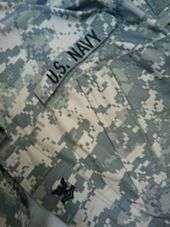
Although common practice (though not required by regulation) with the BDUs, ACUs are not to be starched. As per the ALARACT message in effect until a new revision of AR 670-1 is released, "Soldiers will not starch the Army Combat Uniform under any circumstances. The use of starch, sizing, and any process that involves dry-cleaning or steam press will adversely affect the treatments and durability of the uniform and is not authorized."[18]
Starching the uniform has been shown to cause discoloration. It enhances the IR signature, making the uniform inappropriately bright under night vision viewing.
Personnel have been instructed that the uniform must be washed with a mild detergent that does not contain "optical brighteners." Detergents with optical brighteners may cause discoloration of the uniform, which would nullify the purpose of the very specific camouflage design and result in possible unwanted detection of personnel using the uniforms in combat. Some detergents have phosphorescent properties which enhance an enemy's ability to see the soldier when viewed with night vision devices.
Soldiers have expressed concern about the velcro on the ACU. Dirt and mud can clog the hooks and loops or they can wear out with use, requiring the use of cleaning brushes for clearing the velcro as part of daily maintenance.[19] Zippers have also been a topic of concern. Soldiers also expressed concern because the zippers (as with any zipper) can bind up, and render the uniform uncomfortable to wear, especially with body armor. According to the Program Executive Office Soldier "Commercial Velcro will be sold in clothing sales for the repair/replacement of Velcro. Additionally soldiers have been using the small weapons cleaning brush to clean out any sand and dirt from the pile and it has been working very well."[20]
In 2010, Velcro was phased out in favor of buttons, which are silent, work well in dust, mud and snow, support heavier use and hold more securely.[21]
Initial fielding
The process of replacing the U.S. Army's Woodland Pattern BDU (in use since the early 1980s) and Desert Camouflage Uniform with the ACU was to begin in April 2005. However, the fielding process began two months earlier through the Rapid Fielding Initiative. Soldiers from the 48th Infantry Brigade Combat Team were the first U.S. Army unit, active or reserve, to receive the ACU, subsequently deploying the entire Brigade into OIF combat in May 2005. Initial reception of the ACU was mixed, with complaints of insufficient durability and excessive maintenance.[19] As of the early 2010s, the use of multiple camouflage patterns within a U.S. Army unit is now seldom seen, as the ACU in UCP is now standard issue.
See also
Current
- Airman Battle Uniform
- Marine Corps Combat Utility Uniform
- Navy Working Uniform
- Improved Outer Tactical Vest
- List of camouflage patterns
- Near Infrared (NIR) Signature Management Technology
- CADPAT
- Uniforms of the United States Military
- Uniforms of the United States Army
- U.S. Army Service Uniform
- Army Combat Shirt
Former
References
- ↑ Triggs, Marcia (15 June 2004). "Army unveils new combat uniform, replace Battle Dress Uniform (BDU)". United States Army Public Affairs. United States Department of the Army. Archived from the original on 18 June 2004. Retrieved 18 June 2004.
- ↑ ALARACT 078/2005
- ↑ USA Contracts for New Army Combat Uniforms in ACUPAT Camo – Defense Industry Daily
- ↑ "Advanced Combat Uniform (ACU)" (PDF). October 2010. Retrieved 19 January 2011.
- ↑ "Camouflaging Yourself AND Equipment". Kit Up!. 2009-12-02. Retrieved 2016-10-07.
- ↑ Lopez, C. (20 February 2010). "Soldiers to get new cammo pattern for wear in Afghanistan". US Army. US Army. Retrieved 22 February 2010.
- ↑ Army selects new camo pattern - Armytimes.com, 23 May 2014
- ↑ Army announces rollout date for new camo - Armytimes.com, 31 July 2014
- ↑ Army Unveils Design Changes for New Camo Uniform - Military.com, 6 August 2014
- ↑ Soldiers Line Up to Buy New Camouflage Uniforms - Kitup.Military.com, 8 July 2015
- ↑ ALARACT 164/2006
- ↑ Army Combat Uniform Ensemble, paragraph 5L.
- ↑ Paragraph 5S.
- ↑ Army Combat Uniform (ACU) ALARACT Message 007/2006
- 1 2 PEO Soldier to Unveil New Army Combat Shirt
- ↑ Fleece/Knit Cap Authorization for the ACU
- ↑ http://www.armyg1.army.mil/hr/Foliage%20Green%20t-shirt%20ALARACT%20message.doc. Retrieved 19 April 2008. Missing or empty
|title=(help) - 1 2 FROM
- 1 2 Hirschman, Dave (17 July 2005). "Some Georgia Troops Blister Tattered Desert Uniforms". Atlanta Journal Constitution. Archived from the original on 20 July 2005. Retrieved 16 January 2016.
- ↑ "PM Soldier Equipment - FAQs". United States Army. Archived from the original on 4 May 2007. Retrieved 16 January 2016.
Further reading
External links
| Wikimedia Commons has media related to Army Combat Uniform. |
- Program Executive Office (PEO) Soldier
- PEO Soldier- Army Combat Uniform Factsheet
- PEO Soldier- Army Combat Uniform FAQ
- GlobalSecurity.org page on ACU (with pictures)
- ACU Brief (ArmyStudyGuide.com) – details of proper wear and care of the ACU
- Army page on ACU
- ≠48TH Brigade Combat Team Receives New Army Combat Uniform °404 - File or directory not found[1]
~~~~ - 48th Brigade Combat Team – First Field Reports on ACU
- Soldiers to test new Army Combat pants Army Times

